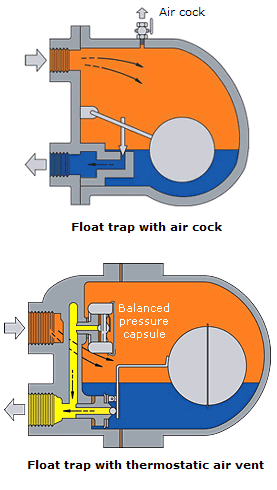The weep hole is usually small enough to prevent significant steam loss but it removes only a limited amount of air which can hinder system start up or heat transfer on equipment.
Bucket type steam trap animation.
Most steam traps pass non condensable gases like air while remaining tight to live steam.
In inverted bucket steam traps the bucket within the trap is attached to a lever that opens and closes the trap valve in response to the bucket s motion.
The inverted bucket steam trap is shown in figure 11 3 3.
Request a quote request a steam system assessment.
When steam or air enters the bucket the bucket gains buoyancy and closes the valve.
These are mechanical type of steam traps working on the principle of buoyancy.
At star up air will enter the steam trap and will be discharged out through the bleed hole.
Inverted bucket steam trap.
Initially the bucket is resting at the bottom of the steam trap and the valve seat is wide open.
The bucket trap uses an inverted bucket as a float device and a linkage connects the bucket to the valve head.
As its name implies the mechanism consists of an inverted bucket which is attached by a lever to a valve.
An essential part of the trap is the small air vent hole in the top of the bucket.
Discharge condensate immediately and completely.
When steam or air flows into the underside of the inverted bucket and condensate surrounds it on the outside the steam causes the bucket to become buoyant and rise.
200 series inverted bucket steam traps.
800 813 series inverted bucket steam traps.
Liquid expansion steam traps the liquid expansion steam trap employs a liquid expansion device to discharge condensate at a predefined temperature.
A steam trap should.
To review a specific inverted bucket steam trap select a series and go to the menu.
Inverted bucket traps are the most robust type of the mechanical traps.
Figure 11 3 3 shows the method of operation.
A steam trap is a self contained valve which automatically drains the condensate from a steam containing enclosure while remaining tight to live steam or if necessary allowing steam to flow at a controlled or adjusted rate.
In contrast inverted bucket type traps typically include an internal weep hole to bleed off steam or air continuously and with each cycle.










